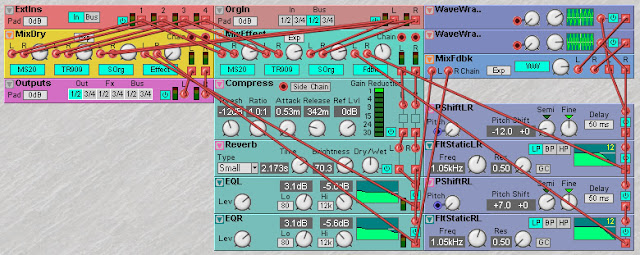Now you can read why the Clavia Nord Modular G2 can be an even more amazing mixer than what I told you in Part.1!
And this is all thanks to a "special" module that I neglected to tell you about before!
But before talking about that, this is the link to Part.1, just in case you missed it!
http://synth-ing.blogspot.pt/2017/01/using-clavia-nord-modular-g2-as-mixer_26.html
Since I wrote that post, I was made aware that the Clavia Nord Modular G2 can actually do a bit more than I thought!
Just for this it was useful to write that post, as it generated a very interesting discussion after I shared it in the Clavia Nord Modular G2 facebook group!
As you probably know by now, each parameter of the Clavia Nord Modular G2 can be assigned to a MIDI CC.
And as you probably know by now as well, you can send different CCs directly from the Clavia Nord Modular G2, either to external gear or to any of the available slots (including the slot you are working with)!
By using a single Constant module into two CtrlSend modules, you are able to control both the left and right channel of your processing chain, as shown in the following image!
So if you were thinking of starting making your own patches for stereo processing, this is a much simpler and more practical solution than using morph groups!
With this important note given, I can finally reveal what module makes has such a huge impact in the versatility of the Clavia Nord Modular G2, if you want to use it as a mixer!
If you checked the post about my Synth-ing Nº3 performance (which you can find here - http://synth-ing.blogspot.pt/2017/02/concert-synth-ing-n3.html), you have probably noticed that I could mix the external signals from the Roland TR-909 and Electrix Repeater (using the Korg MS-20 as the sound source), together with the organ sound I made for the Clavia Nord Modular G2X and that is used in a different slot!
 |
| SimpleN3Mix, the mixer patch I used for Synth-ing Nº3! |
With these 4 bus channels, you are able to send up to 4 different signals from one slot to another, which means you can easily end up with a mixer with 8 channels, if you want to mix signals that come from other slots!
To illustrate this, I present you a simple mixer patch I programmed before named HBD2016MixerV2:
In this case, all inputs were paired in stereo, with two effect chains being used!
Those nice effect chains are the main reason why it is so much better to have a mixer patch in your Clavia Nord Modular G2 for all the slots, rather than just controlling the output at the end of your individual patches, as you are forced to do on the Clavia Nord Modular G1 (despite on that synth this wouldn't be as useful as you can't really use any effects that make use of delays, unless they are really short delays).
And if that is not enough, you can still use the Fx-In modules to add up to 4 extra channels!
What this module does is transferring signal from the polyphonic section of your patch (VA section) to the monophonic section (FX section) of the same patch (only the bus channels allow you to transfer signal from one patch to another)
So, if you build a patch with a mixer in the FX section (where it belongs), and then add a synthesizer voice to the VA section, the best way to get your signal in the mixer is to use the Fx-In module.
In my last performance, Synth-ing Nº4, I used a patch named Mix&Strings that featured a simple synthesizer voice in the VA section, plus the actual mixer in the FX section:
 |
| Mix&Strings, a simple string synth plus a nice mixer with two effects chain! |
In this particular patch, I made no use of the 4 external analog inputs, but as long as you have processing power and memory available, it wouldn't be a problem to add those extra channels!
Another way to expand the amount of channels available would be to program monophonic sounds in the FX section of your patch together with the mixer!
I haven't done a patch using making use of this strategy, but I'd say the most obvious application would be to add extra drum sounds to your mix.
Adding drum sounds means you'll have to cut on the processing for your mixer, but I think it should be possible to come up with something interesting, especially if you use lots of OscPerc and simple synth chains to generate your drum sounds.
The Mix&Strings patch could have also been done this way as well, since it is used to play a monophonic synth sound.
The true advantage of using the Fx-In module is shown when the sound played is actually polyphonic, otherwise it might be better to fit your synth structure in the FX section of your patch, together with the rest of your mixer, as that way you are able to use the same modulators on the FXs (while the EGs might not be that useful for the mixer, the LFOs will most likely be).
And I think this concludes this series of "Using the Clavia Nord Modular G2 as a mixer!", which I really hope you enjoyed!
If you have made use of other tricks to create amazing mixers on your Clavia Nord Modular G2, just let me know and I'll definitely be giving it a try and create a new post about it as well!
And if you have a suggestion for a future topic related with the Clavia Nord Modular G2, just drop the idea here and I'll try to work on it ;)










Sem comentários:
Enviar um comentário